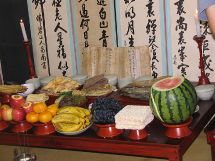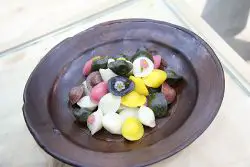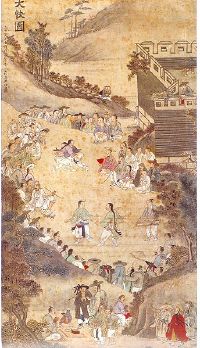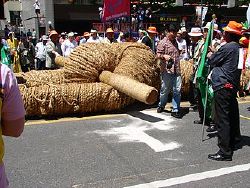Chuseok
| Chuseok | |
|---|---|

| |
| Jesasang, ceremonial table setting on Chuseok. | |
| Official name | Chuseok (추석, 秋夕) |
| Also called | Hangawi, Jungchu-jeol |
| Observed by | Koreans |
| Type | Cultural, religious (Buddhist, Confucian, Muist) |
| Significance | Celebrates the harvest |
| Begins | 14th day of the 8th lunar month |
| Ends | 16th day of the 8th lunar month |
| Observances | Visit to their family's home town, ancestor worship, harvest feasts with songpyeon and rice wines |
| Related to | Mid-Autumn Festival (in China and Vietnam) Tsukimi (in Japan) Uposatha of Ashvini/Krittika (similar festivals that generally occur on the same day in Cambodia, India, Sri Lanka, Myanmar, Laos, and Thailand ) |
Chuseok (Korean: 추석; hanja: 秋夕), literally "Autumn eve," once known as hangawi (Korean: 한가위); from archaic Korean for "the great middle (of autumn)"), is a major harvest festival and a three-day holiday in both [North Korea|North]] and South Korea. It is celebrated on the 15th day of the eight month of the lunar calendar on the full moon. Like many other harvest festivals around the world, it is held around the autumn equinox at the very end of summer or early autumn.
As a celebration of the good harvest, Koreans visit their ancestral hometowns and share a feast of Korean traditional food such as songpyeon (Hangul: 송편) and rice wines such as sindoju and dongdongju. There are two major traditions related to Chuseok: Charye (차례), ancestor memorial services at home, and Seongmyo (Hangul: 성묘), family visit to the ancestral graves.
Origins
According to popular belief, Chuseok originates from gabae (Hangul: 가배). Gabae started during the reign of the third king of the kingdom of Silla (57 B.C.E. - 935 C.E.)[1]
Many scholars believe Chuseok may originate from shamanistic celebrations of the harvest moon.[1] New harvests are offered to local deities and ancestors, which means Chuseok may have originated as a worship ritual.
Traditional customs
Chuseok celebrates the bountiful harvest and strives for the next year to be better than the last. During this time the ancestors are honored, in special ceremonies.
Charye
Charye is one of the ancestral memorial rites celebrated during Chuseok, symbolizing the returning of favors and honoring ancestors and past generations.[2]
The rite involves the gathering of families in holding a memorial service for their ancestors through the harvesting, preparation, and presentation of special foods as offerings.[3] The rite embodies the traditional view of spiritual life beyond physical death, respecting the spirits of the afterlife that now also serve to protect their descendants.
The foods offered have traditionally varied across provinces depending on what was available. Foods for the offering table must include freshly harvested rice, alcohol, and songpyeon (half-moon rice cakes), prepared as an offering to the family’s ancestors.[4] The family members then enjoy a festive meal which may include fish, chicken, and seasonal vegetables.
Seongmyo and Beolcho
Seongmyo, visiting the ancestors' graves, and Beolcho, cleaning the grave sites, are also done during Chuseok week. These old traditions are carried out to show respect and appreciation for family ancestors.
Usually people visit these ancestral grave sites several days before Chuseok in order to remove weeds that have grown there over the summer. This custom of Beolcho is considered a duty and an expression of devotion.[5]
During seongmyo, family members gather at their ancestors' graves and pay respect to the deceased with a simple memorial service.
Food
Songpyeon
One of the major foods prepared and eaten during the Chuseok holiday is songpyeon (Hangul: 송편; 松편), a Korean traditional rice cake[4] stuffed with ingredients such as sesame seeds, black beans, mung beans, cinnamon, pine nut, walnut, chestnut, jujube, and honey. When making songpyeon, during the steaming process, the rice cakes are layered with pine needles. The word song in songpyeon means pine tree in Korean. The pine needles not only contribute to songpyeon's aromatic fragrance, but also its beauty and taste.[5][6]
Songpyeon is also significant because of the meaning contained in its shape. The round rice skin itself resembles the shape of a full moon, but once it is wrapped around the filling, its shape resembles a half-moon. Since the Three Kingdoms era in Korean history, a Korean legend stated that these two shapes ruled the destinies of the two greatest rival kingdoms, Baekje and Silla. During the era of King Uija of Baekje, an encrypted phrase, "Baekje is full-moon and Silla is half moon" was found on a turtle's back and it predicted the fall of the Baekje and the rise of the Silla. The prophecy came true when Silla defeated Baekje. Ever since, Koreans have believed a half-moon shape is an indicator of a bright future or victory.[6] Therefore, during Chuseok, families gather together and eat half-moon-shaped Songpyeon under the full moon, wishing for a brighter future.[5]
Hangwa
Another popular Korean traditional food that people eat during Chuseok is hangwa. It is an artistic food decorated with natural colors and textured with patterns. Hangwa is made with rice flour, honey, fruit, and roots. People use edible natural ingredients to express various colors, flavors, and tastes. Because of its decoration and nutrition, Koreans eat hangwa not only during Chuseok, but also for special events, for instance, weddings, birthday parties, and marriages.[7]
The most famous types of hangwa are yakgwa, yugwa, and dasik. Yakgwa is a medicinal cookie which is made of fried rice flour dough ball, and yugwa is a fried cookie that also refers to a flower. Dasik is a tea cake that people enjoy with tea.[8]
Baekseju
A major element of Chuseok is the alcoholic beverages. Liquor drunk on Chuseok is called baekju (白酒, literally "white liquor") and nicknamed sindoju (新稻酒, literally "new rice liquor") as it is made of freshly harvested rice.
Kooksoondang, a maker of Korean traditional liquors, restored "Yihwaju," rice wine from the Goryeo era (918–1392), and "Songjeolju" that has been widely enjoyed by Joseon (1392–1910) aristocrats. Its "Jayang Baekseju" package comprises a variety of liquors ― Jayang Baekseju, Jang Baekseju, Baekokju ― that are claimed to enhance men's stamina.
Adults say that if you drink the alcoholic beverage which the ancestors have drunk; there will be nothing you'll be scared of.[9][10]
Others
Other foods commonly prepared are japchae, bulgogi, an assortment of Korean pancakes and fruits.
Gifts
History of Chuseok gifts
The Korean people started sharing daily necessities, such as sugar, soap or condiments, as Chuseok gifts in the 1960s. The gifts have changed since the Korean economy has developed. In the 1970s, Korean people had more options for Chuseok gifts; examples include cooking oil, toothpaste, instant coffee sets, cosmetics, television and rice cookers. People chose gift sets of fruit, meat and cosmetics in the 1980s. In the 1990s, people used gift vouchers for Chuseok. In the 21st century, more sophisticated gifts, such as sets of olive oil, natural vinegar and electronic devices have become the most popular option for Chuseok gifts.[11]
Types of Chuseok gifts and prices
There are some extravagant gifts that can be purchased: one kilogram of wild pine mushrooms, which are expensive because they cannot be artificially grown, (560,000 won) US$480.27 and red ginseng products (1.98 million won) US$1698.11. However, the most exorbitantly priced gift is six bottles of wine at Lotte Department Store for a staggering (33 million won) US$28,301.89.[12]
Chuseok gift sets are big business in Korea, and prices are typically inflated.[13]
Folk games
A variety of folk games are played on Chuseok to celebrate the coming of autumn and rich harvest. Village folk dress themselves to resemble a cow or turtle, and go from house to house along with a nongak band playing music. Other common folk games played on Chuseok are archery, ssireum (Korean wrestling), and juldarigi (tug-of-war); folk games vary by region.
Ssireum
Ssireum (Hangul: 씨름) is the most popular Korean sport played during Chuseok, and contests are usually held during this holiday. Scholars have found evidence for ssireum's dating back to the Goguryeo dynasty, Ssireum is assumed to have 5000 years of history. Two players wrestle each other while holding onto their opponent's satba, a red and blue band. A player loses when his upper body touches the ground, and the winner becomes Cheonha Jangsa, Baekdu Jangsa, or Halla Jangsa, meaning "the most powerful". The winner gets a bull and 1 kg of rice as the prize.[14] Due to its popularity among both the young and the old, ssireum contests are held more frequently, not limited to important holidays.
Taekkyon
Taekkyon (Hangul: 태껸 or 택견) is one of the oldest traditional martial arts of Korea. Taekkyon was very popular during the Joseon period where it was practiced alongside Ssireum during festivities, including Chuseok. Though originally a hand-to-hand fighting method, plebs used a more tamed version alike to a kicking game. The practitioner uses the momentum of his opponent to knock him down through kicks, swipes and pushes[15]. Tournaments between players from different villages were carried out, starting with the children ("Aegi Taekkyon") before finishing with the adults.
Taekkyon almost disappeared during the Japanese occupation (1910-1945) but is now considered a cultural heritage of Korea (1983) and a UNESCO intangible cultural item (2011)[16].
Ganggangsullae
The Ganggangsullae(Hangul: 강강술래) dance is a traditional folk dance performed under the full moon on the night of Chuseok.[17] Women wear Korean traditional dress, hanbok, make a big circle by holding hands, and sing a song while going around a circle.
The dance originated in the southern coastal area during the Joseon dynasty. It takes its name from the refrain repeated after each verse, although the exact meaning of the word is unknown.[18]
For other folk games, they also play Neolttwigi (also known as the Korean plank), a traditional game played on a wooden board.[19]
Juldarigi
Juldarigi (Hangul: 줄다리기), or tug-of-war, was enjoyed by an entire village population. Two groups of people are divided into two teams representing the female and male forces of the natural world. The game is considered an agricultural rite to augur the results of the year's farming. If the team representing the female concept won, it was thought the harvest that year would be rich.
So-nori is a comedic performance in which people used a straw mat to disguise themselves as a cow and call from door to door for all to get together and share food.
Chicken Fight (Dak Sa Um)
Korean people used to watch chicken fights (Hangul: 닭싸움), and learned how chickens fought; a game inspired by such was invented.
To play the game, people are separated into two balanced groups. One must bend his or her leg up and hold it bent with the knee poking out. The players must then attack each other with their bent knees, having to eliminate them by making their feet touch the ground; the last player holding up his or her knee wins.
The game is about strength, speed, and balance; in order to stay alive, one must display the capability of fighting back.[20]
Hwatu
Hwatu, or Go-Stop (Hangul: 화투) is composed of 48 cards including 12 kinds. It originated from a Japanese card game called Hanafuda, and is the most popular card game played by Koreans today. The rules of the game and the term hwatu originated from Tujeon. Early hwatu was similar to Hanafuda, but was changed due to similarities with the latter. It went through a course that made it reduced by four base colors and thinner than before, spreading throughout to turn out goods on a mass-produced basis.
Contemporary Celebrations
South Korea
In contemporary South Korea, on Chuseok, masses of people travel from large cities to their hometowns to pay respect to the spirits of their ancestors.[4] People perform ancestral worship rituals early in the morning. Then, they visit the tombs of their immediate ancestors to trim plants and clean the area around the tomb, and offer food, drink, and crops to their ancestors.[4] South Koreans consider autumn the best season of the year due to clear skies, cool winds, and it is a perfect harvesting season. Harvest crops are attributed to the blessing of ancestors. Chuseok is commonly translated as "Korean Thanksgiving" in American English.[21] Although most South Koreans will be visiting their families and ancestral homes, there are festivities held at the National Folk Museum of Korea. Many places are closed during this national holiday including: banks, schools, post offices, governmental departments, stores, etc. Travel tickets are usually sold out three months in advance and roads and hotels are overcrowded.[22]
North Korea
Since Chuseok has been a traditional holiday since long before the division of Korea, people in North Korea also celebrate Chuseok. However, the ideology that divided Korea also caused some differences between Chuseok of North Korea and that of South Korea.[23] Since the division, South Korea has adopted a westernized culture, so the way South Koreans enjoy the holiday is a typical way of enjoying holidays with family members. However, North Korea moved away from the traditional ways; in fact, North Korea did not celebrate Chuseok and other traditional holidays until the mid-1980s.
Though most North Koreans do not have any family gatherings during Chuseok, some, especially those in working classes, try to visit their ancestors's grave sites during Chuseok. However, social and economic issues in North Korea have been preventing visits.[24] In addition, their extremely poor infrastructure, especially in terms of public transportation, make it almost impossible for people to visit grave sites and their families.[25] In contrast to the poorly situated lower class North Koreans, middle and elite classes enjoy the holiday as they want, easily traveling wherever they want to go.[25]
Notes
- ↑ 1.0 1.1 Charles E. Farhadian, Christian Worship Worldwide: Expanding Horizons, Deepening Practices (Wm. B. Eerdmans Publishing, 2007, ISBN 0802828531).
- ↑ Korean Ancestral Memorial Rites, Jerye Korea4Expats. Retrieved October 10, 2019.
- ↑ Kimberly Comeau , A time for families, food and festivities The Jeju Weekly, September 12, 2011. Retrieved October 10, 2019.
- ↑ 4.0 4.1 4.2 4.3 Traditional Korean Holiday of Bountiful Harvest, Chuseok Korea Tourism Organization, September 2, 2019. Retrieved October 10, 2019. Cite error: Invalid
<ref>tag; name "KTO" defined multiple times with different content - ↑ 5.0 5.1 5.2 Chuseok – Full Moon Harvest Holiday Korea Tourist Organization. Retrieved October 10, 2019.
- ↑ 6.0 6.1 No Chuseok Without Songpyeon. Retrieved 27 December 2018.
- ↑ [1]
- ↑ Korea Tour Guide. Retrieved 22 September 2016.
- ↑ Korea Herald. Retrieved 27 December 2018.
- ↑ Archived copy.
- ↑ 한국을 대표하는 글로벌 방송! The World On Arirang!. Retrieved 27 December 2018.
- ↑ [2]
- ↑ 10 Ridiculously Priced Korean Chuseok Gift Sets - 10 Magazine Korea (23 September 2015).
- ↑ What's on Korea. (2001, July 28) {{#invoke:webarchive|webarchive}}
- ↑ the importance of Taekkyon in Korean traditionnal culture.
- ↑ Taekkyon entry on UNESCO's world heritage list.
- ↑ Seoul City. (2004, September 2) {{#invoke:webarchive|webarchive}}
- ↑ Ganggangsullae UNESCO Intangible Heritage. Retrieved October 6, 2019.
- ↑ Festivals, events to delight on Chuseok holidays. Retrieved 22 September 2016.
- ↑ [3]
- ↑ Chuseok: Korean Thanksgiving Day. Retrieved 22 September 2016.
- ↑ Lee, Cecilia Hae-Jin (2010). Frommer's South Korea. Hoboken, N.J, Chichester: Wiley, John Wiley, 21, 22, 25. ISBN 0470591544.
- ↑ "Chuseok— A Festival With Two Faces", 10 September 2011.
- ↑ Archived copy.
- ↑ 25.0 25.1 Jin, Im Jeong (23 September 2010). Welcome to Chuseok, North Korean Style.
ReferencesISBN links support NWE through referral fees
- Farhadian, Charles E. Christian Worship Worldwide: Expanding Horizons, Deepening Practices. Wm. B. Eerdmans Publishing, 2007. ISBN 0802828531
- National Folk Museum of Korea (South Korea) Encyclopedia of Korean Seasonal Customs. Gil-Job-Ie Media, 2015. ASIN B019TYXACC
- The Academy of Korean Studies, ed. (1991), "Chuseok", Encyclopedia of Korean People and Culture, Woongjin (in Korean)
- Farhadian, Charles E. (2007). Christian Worship Worldwide. Wm. Bm. Eerdmans Publishing. ISBN 978-0-8028-2853-8.
- (1982) Korean Heritage Overview. Korea University. (in Korean)
- Aviles, K. (2011, September 10). Chuseok : A Festival With Two Faces. International Business Times. Retrieved December 4, 2012 Chuseok— A Festival With Two Faces 10 September 2011 International Business Times
- Im, J. J. (2010, September 23). Daily NK - Welcome to Chuseok, North Korean Style. DailyNK. Retrieved December 4, 2012 Welcome to Chuseok, North Korean Style Im Jeong Jin 23 September 2010 Dailynk.com </ref>
- Kim, K.-C. (2008). Ganggangsullae. UNESCO Multimedia Archives. Retrieved December 4, 2012 Ganggangsullae Kim Kwang-shik-CHA Unesco.org</ref>
- Korea.net. (2012, February 5). Chuseok, Korean Thanksgiving Day (English) - YouTube. YouTube. Retrieved December 4, 2012 Chuseok, Korean Thanksgiving Day (English)
- Moon, S. H. (2008, September 16). Daily NK - New Chuseok Trends in North Korea. DailyNK. Retrieved December 4, 2012
- Official Korea Tourism. (2008, August 26). Official Site of Korea Tourism Org.: Chuseok : Full Moon Harvest Holiday, Korean Version of Thanksgiving Day. VisitKorea. Retrieved December 4, 2012
- The National Folklore Museum of Korea. (n.d.). Ancestral Memorial Rites - Charye | The National Folklore Museum of Korea. The National Folklore Museum of Korea. Retrieved December 5, 2012 [http://www.nfm.go.kr/Data/cuThar.jsp 메세지 페이지 Nfm.go.kr
- TurtlePress (Martial Arts Video). (2009, May 1). SSireum Korean Wrestling History - YouTube. YouTube. Retrieved December 4, 2012 SSireum Korean Wrestling History
- Yoo, K. H. (2009, October 5). Chuseok, North Korean Style. DailyNK. Retrieved December 4, 2012 Chuseok, North Korean Style Yoo Gwan Hee Dailynk.com
External links
All links retrieved
- What Is Chuseok?
- Traditional Korean Holiday of Bountiful Harvest, Chuseok
- Chuseok, Korean Thanksgiving Day at YouTube
- How to Celebrate Chuseok in South Korea
- Chuseok (Harvest Moon Festival) 2019
Credits
New World Encyclopedia writers and editors rewrote and completed the Wikipedia article in accordance with New World Encyclopedia standards. This article abides by terms of the Creative Commons CC-by-sa 3.0 License (CC-by-sa), which may be used and disseminated with proper attribution. Credit is due under the terms of this license that can reference both the New World Encyclopedia contributors and the selfless volunteer contributors of the Wikimedia Foundation. To cite this article click here for a list of acceptable citing formats.The history of earlier contributions by wikipedians is accessible to researchers here:
The history of this article since it was imported to New World Encyclopedia:
Note: Some restrictions may apply to use of individual images which are separately licensed.



